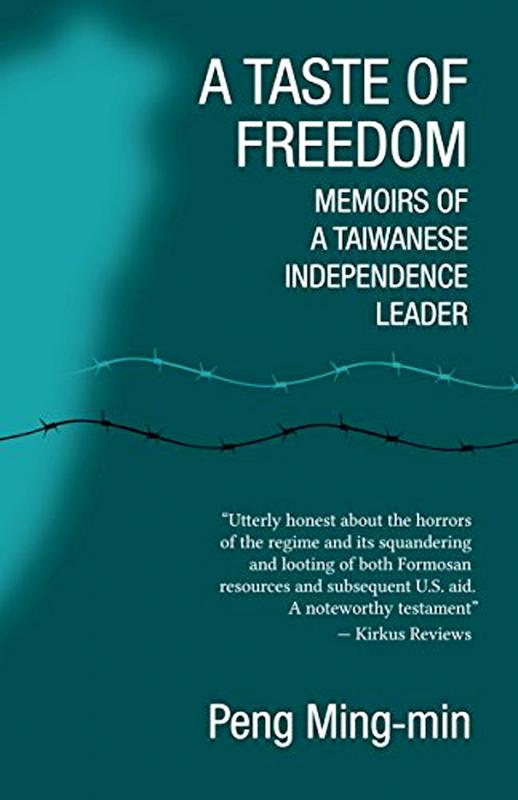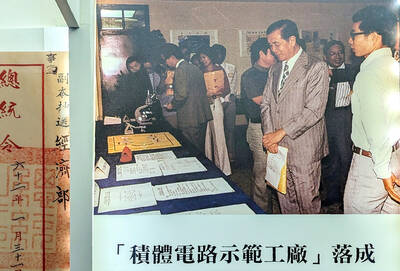This vivid memoir begins with Taiwanese democracy activist Peng Ming-min (彭明敏) rejoicing that he is on the open ocean and finally beyond the clutches of the Chinese Nationalist Party (KMT). The year is 1969 and Peng has endured 14 months in jail, plus four years surveillance as a dangerous dissident. But now he is free, having been freed from jail by former president Chiang Kai-shek (蔣介石) against all the odds.
The death of Peng in April has thrust this important figure back into the limelight. And Camphor Press has recently reissued A Taste of Freedom: Memoirs of a Formosan Independence Leader, first published in 1972.
Though he came from a medical family, Peng opted to study literature, both in Taipei and later in Japan. He notes that he was drawn to French writers, and remembers being especially influenced by Ernest Renan and his essay on what makes a nation. Renan’s conclusion that it was neither race nor language nor culture that mattered but a shared sense of one’s communal destiny. This shaped his later attitudes about Taiwan’s future.

At this time Peng was studying in Japan, in Kyoto and, later, in Nagasaki. He was in Nagasaki on the day of the US atomic bombing of the city, though he had in fact suffered the loss of an arm during a slightly earlier, “conventional” bombing of the city. His descriptions of both bombings, not to mention the festering wound in his shoulder, are horrific.
After the end of World War II, Taiwanese were allowed to return to their homeland from Japan. Peng went to Kaohsiung where his father held a high-ranking medical position. Once there, he witnessed the arrival, and subsequent behavior, of the KMT troops. Once, he relates, when “a large number of leading Kaohsiung citizens had gathered in the city auditorium to debate the [228 Incident], the doors were closed and the chamber swept with machine gun fire. Families were compelled to watch the public execution of fathers and sons in the square before the railway station. There were many stories of torture inflicted on prisoners before their execution.”
PRISON YEARS
Why did Chiang release Peng from prison? Firstly, he was seen as a withdrawn, bookish type. His main offense had been helping draft a document detailing the principles of a future, democratic state in Taiwan. But for four years after his release he and his family were subjected to intense surveillance. He was not allowed to resume his teaching position at National Taiwan University, and even though he had meetings with former president Chiang Ching-kuo (蔣經國), but no effective cooperation took place. He had been identified as someone who might improve the government’s image, but Peng was unwilling to be an active KMT member.
There are almost as many pages devoted to Peng’s four post-prison years, dealing with the Taiwan Presbyterian Church, Academia Sinica and the World Council of Churches, not to mention the Red Cross and Taipei’s relations with Tokyo, as there are dealing with his interrogations.
Peng then decided that this kind of life was intolerable and he made secret plans to emigrate. He chose Sweden where the offices of Amnesty International were proving most cooperative. His successful flight made international news, with the KMT press making out that it had all been arranged by the CIA.
Peng loved Sweden, but couldn’t really work there without speaking Swedish. He therefore accepted an invitation from the University of Michigan to go there as a researcher. This accomplished, he embarked on several lecture tours in which he discoursed on the fate of incarcerated political dissidents worldwide, and especially on the situation in Taiwan. This latter, with an extensive focus on the rights of Taiwanese to determine their own political future, is extensively repeated in this book.
He would point out to audience members who said Taiwan had always been a part of China that as recently as 1875 China had forbidden free migration to the island, and only eight years later ceded it to Japan.
All the Taiwanese living in the US knew that there were KMT agents in all the universities keeping a watch on their behavior, Peng asserts.
THE PROFESSOR
Peng finally returned to the National Taiwan University, to its Department of Political Science in the College of Law.
Next came an offer from McGill University in Canada of funding for a two-year stay to complete an MA course. This he successfully completed, writing his thesis in French. His subject was the future legal provision in the field of space travel. After this he completed a PhD thesis on a similar subject in Paris.
Back in Taiwan Peng was offered numerous eminent positions, some of which he accepted. The KMT was clearly anxious to recruit him to their cause, but Peng was developing other ideas. He became involved in drafting a manifesto urging profound reform, and subsequent to this was arrested. This was now 1964.
This is a fascinating book. The contrast between the adolescent studiousness and the adult positions of power is only the beginning of it. Casual insights abound. The protracted descriptions of interrogations under the KMT are reminiscent of Tehpen Tsai’s (蔡德本) Elegy of Sweet Potatoes (reviewed in the Taipei Times, May 13, 2021). Indeed, some suspected that Peng lost his arm while being tortured by the KMT, though he always maintained that he was never beaten. In both books the victims are mostly professors who had worked abroad, and were hence “suspect.”
The memoir ends with the agreement at the UN in 1971 on China’s right to a seat there. This, in other words, is a historical document, focusing on the situation over Taiwanese sovereignty issues up to that point.

Oct. 27 to Nov. 2 Over a breakfast of soymilk and fried dough costing less than NT$400, seven officials and engineers agreed on a NT$400 million plan — unaware that it would mark the beginning of Taiwan’s semiconductor empire. It was a cold February morning in 1974. Gathered at the unassuming shop were Economics minister Sun Yun-hsuan (孫運璿), director-general of Transportation and Communications Kao Yu-shu (高玉樹), Industrial Technology Research Institute (ITRI) president Wang Chao-chen (王兆振), Telecommunications Laboratories director Kang Pao-huang (康寶煌), Executive Yuan secretary-general Fei Hua (費驊), director-general of Telecommunications Fang Hsien-chi (方賢齊) and Radio Corporation of America (RCA) Laboratories director Pan
The consensus on the Chinese Nationalist Party (KMT) chair race is that Cheng Li-wun (鄭麗文) ran a populist, ideological back-to-basics campaign and soundly defeated former Taipei mayor Hau Lung-bin (郝龍斌), the candidate backed by the big institutional players. Cheng tapped into a wave of popular enthusiasm within the KMT, while the institutional players’ get-out-the-vote abilities fell flat, suggesting their power has weakened significantly. Yet, a closer look at the race paints a more complicated picture, raising questions about some analysts’ conclusions, including my own. TURNOUT Here is a surprising statistic: Turnout was 130,678, or 39.46 percent of the 331,145 eligible party

The classic warmth of a good old-fashioned izakaya beckons you in, all cozy nooks and dark wood finishes, as tables order a third round and waiters sling tapas-sized bites and assorted — sometimes unidentifiable — skewered meats. But there’s a romantic hush about this Ximending (西門町) hotspot, with cocktails savored, plating elegant and never rushed and daters and diners lit by candlelight and chandelier. Each chair is mismatched and the assorted tables appear to be the fanciest picks from a nearby flea market. A naked sewing mannequin stands in a dimly lit corner, adorned with antique mirrors and draped foliage

The older you get, and the more obsessed with your health, the more it feels as if life comes down to numbers: how many more years you can expect; your lean body mass; your percentage of visceral fat; how dense your bones are; how many kilos you can squat; how long you can deadhang; how often you still do it; your levels of LDL and HDL cholesterol; your resting heart rate; your overnight blood oxygen level; how quickly you can run; how many steps you do in a day; how many hours you sleep; how fast you are shrinking; how